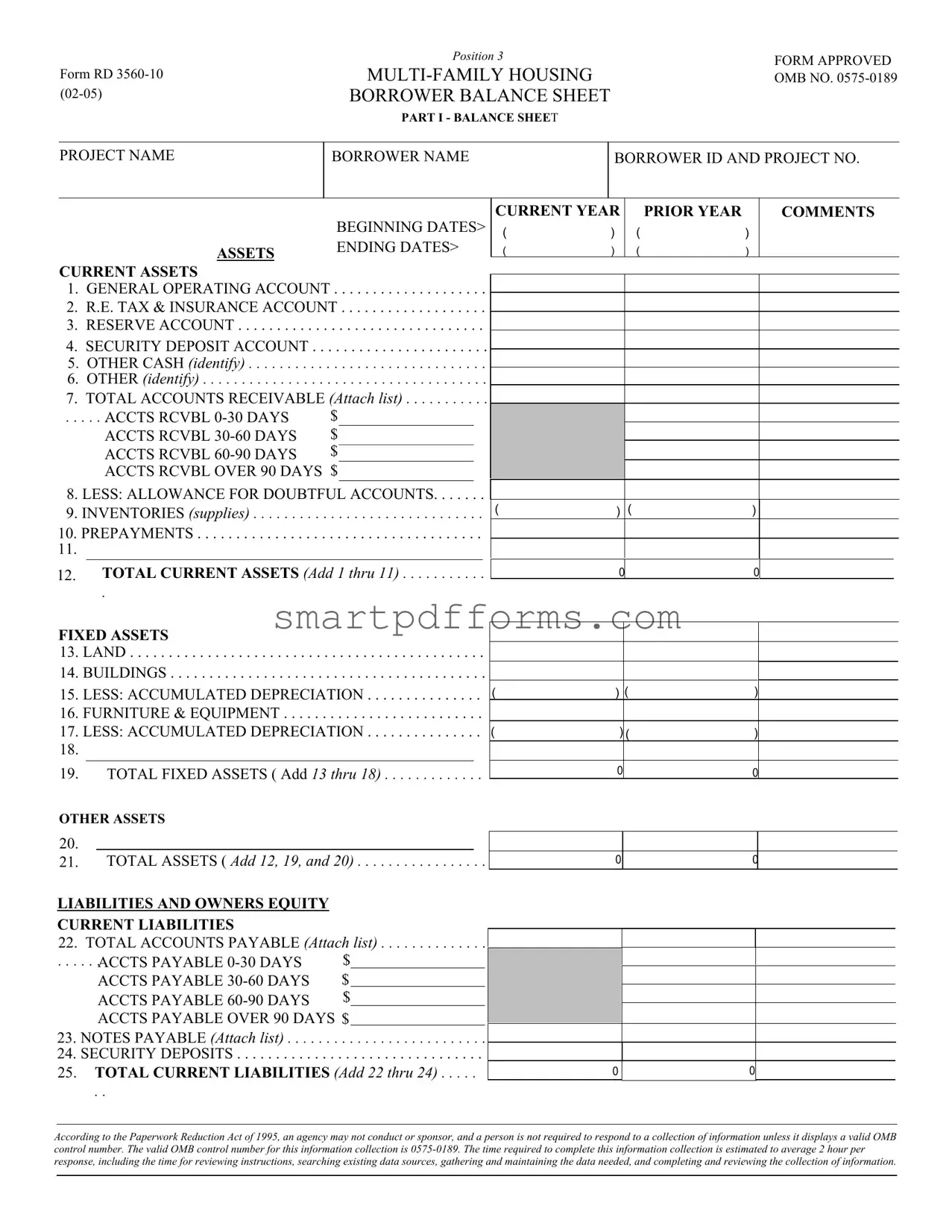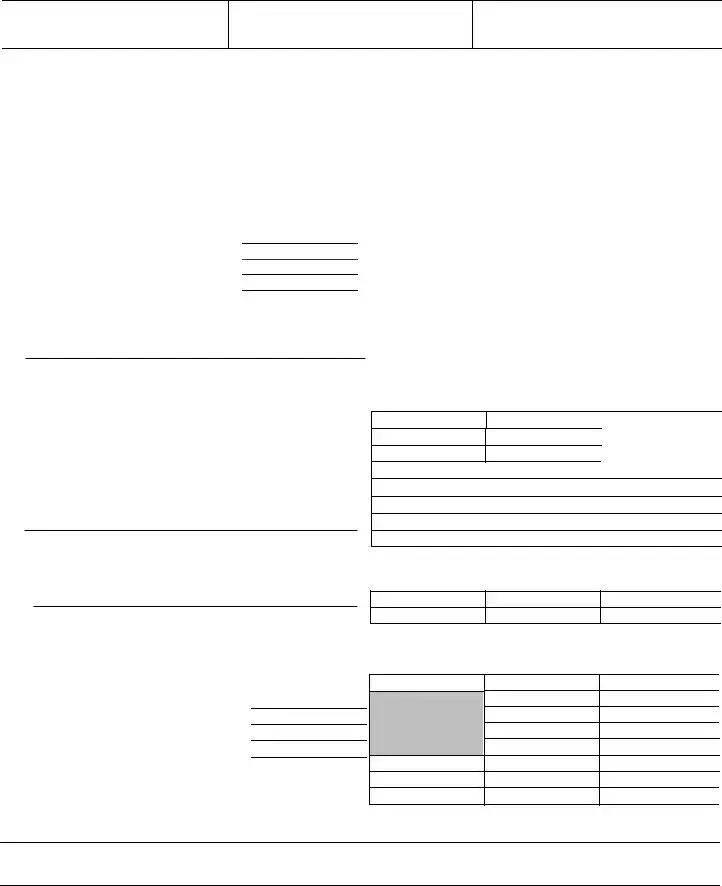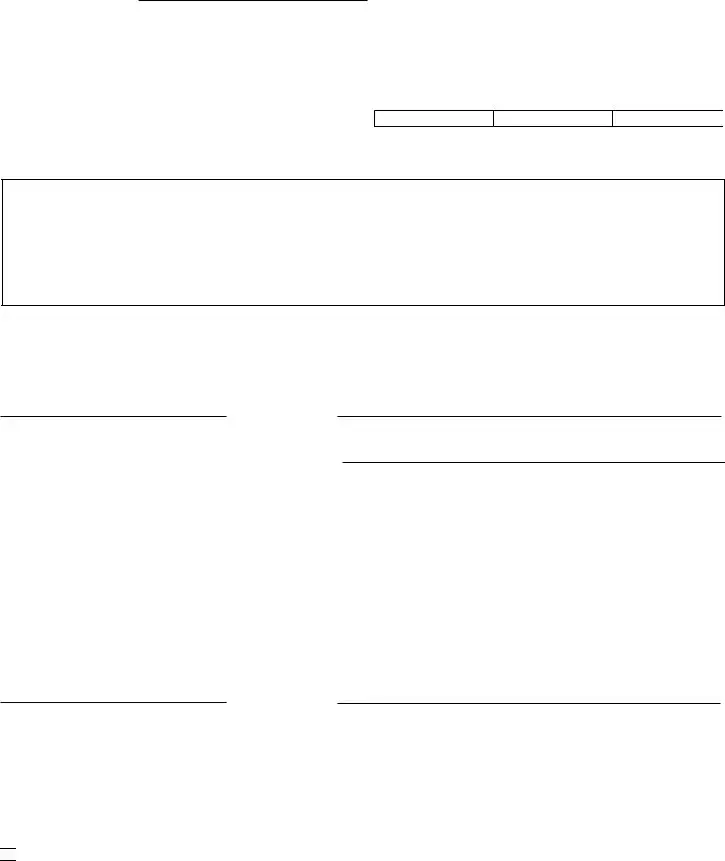|
Position 3 |
FORM APPROVED |
|
MULTI-FAMILY HOUSING |
Form RD 3560-10 |
OMB NO. 0575-0189 |
(02-05) |
BORROWER BALANCE SHEET |
|
|
PART I - BALANCE SHEET |
|
BORROWER ID AND PROJECT NO.
|
|
BEGINNING DATES> |
|
ASSETS |
ENDING DATES> |
|
|
CURRENT ASSETS |
|
1. |
GENERAL OPERATING ACCOUNT |
. . . . . . . . . . . . . . . . . . . . |
2. |
R.E. TAX & INSURANCE ACCOUNT |
3. |
RESERVE ACCOUNT |
. . . . . . . . . . . . . . . . . . . . |
4. SECURITY DEPOSIT ACCOUNT . . . . . . . . . . . . . . . . . . . . . . .
5. OTHER CASH (identify) . . . . . . . . . . . . . . . . . . . . . . . . . . . . . . .
6. OTHER (identify) . . . . . . . . . . . . . . . . . . . . . . . . . . . . . . . . . . . . .
7. TOTAL ACCOUNTS RECEIVABLE (Attach list) . . . . . . . . . . .
. . . . . ACCTS. . RCVBL 0-30 DAYS |
$ |
ACCTS RCVBL 30-60 DAYS |
$ |
ACCTS RCVBL 60-90 DAYS |
$ |
ACCTS RCVBL OVER 90 DAYS $
8. LESS: ALLOWANCE FOR DOUBTFUL ACCOUNTS. . . . . . .
9. INVENTORIES (supplies) . . . . . . . . . . . . . . . . . . . . . . . . . . . . . .
10. PREPAYMENTS . . . . . . . . . . . . . . . . . . . . . . . . . . . . . . . . . . . . .
11.
12. TOTAL CURRENT ASSETS (Add 1 thru 11) . . . . . . . . . . .
.
CURRENT YEAR |
PRIOR YEAR |
|
COMMENTS |
( |
) |
( |
) |
|
( |
) |
( |
) |
|
FIXED ASSETS
13. LAND . . . . . . . . . . . . . . . . . . . . . . . . . . . . . . . . . . . . . . . . . . . . . .
14. BUILDINGS . . . . . . . . . . . . . . . . . . . . . . . . . . . . . . . . . . . . . . . . .
15. LESS: ACCUMULATED DEPRECIATION . . . . . . . . . . . . . . .
16. FURNITURE & EQUIPMENT . . . . . . . . . . . . . . . . . . . . . . . . . .
17. LESS: ACCUMULATED DEPRECIATION . . . . . . . . . . . . . . .
18.
19. TOTAL FIXED ASSETS ( Add 13 thru 18) . . . . . . . . . . . . .
20.
21. TOTAL ASSETS ( Add 12, 19, and 20) . . . . . . . . . . . . . . . . .
LIABILITIES AND OWNERS EQUITY
CURRENT LIABILITIES
22. TOTAL ACCOUNTS PAYABLE (Attach list) . . . . . . . . . . . . . .
. . . . . .ACCTS PAYABLE 0-30 DAYS |
$ |
ACCTS PAYABLE 30-60 DAYS |
$ |
ACCTS PAYABLE 60-90 DAYS |
$ |
ACCTS PAYABLE OVER 90 DAYS $
23. NOTES PAYABLE (Attach list) . . . . . . . . . . . . . . . . . . . . . . . . . .
24. SECURITY DEPOSITS . . . . . . . . . . . . . . . . . . . . . . . . . . . . . . . .
25. TOTAL CURRENT LIABILITIES (Add 22 thru 24) . . . . .
. .
According to the Paperwork Reduction Act of 1995, an agency may not conduct or sponsor, and a person is not required to respond to a collection of information unless it displays a valid OMB control number. The valid OMB control number for this information collection is 0575-0189. The time required to complete this information collection is estimated to average 2 hour per response, including the time for reviewing instructions, searching existing data sources, gathering and maintaining the data needed, and completing and reviewing the collection of information.
LONG-TERM LIABILITIES
26.NOTES PAYABLE RURAL DEVELOPMENT
27.OTHER (Identify)
28.TOTAL LONG-TERM LIABILITIES (Add 26 and 2 7)
29.TOTAL LIABILITIES (Add 25 and 28) . . . . . . . . . . . . .
30. OWNER'S EQUITY (Net Worth) (21 minus 29) . . . . . . . . . . .
31.TOTAL LIABILITIES AND OWNER'S EQUITY (Add 29 and 30)
Warning: Section 1001 of Title 18, United States Code provides: ''Whoever, in any matter within the jurisdiction any ofdepartmentdepartment or agency of the United States knowingly and willfully falsifies, conceals or covers up by any trick,
scheme, or device a material fact, or makes any false, fictitious or fraudulent statements or representations, or makes or uses any false writing or document knowing the same to contain any false, fictitious or fraudulent statement or entry, shall be fined under this title or imprisoned not more than five years, or both.
I HAVE READ THE ABOVE WARNING STATEMENT AND I HEREBY CERTIFY THE FOREGOING INFORMATION IS COMPLETE AND ACCURATE TO THE BEST OF MY KNOWLEDGE.
(Date) |
(Signature of Borrower or Borrower' Representative) |
(Title)
PART II - VERIFICATION OF REVIEW
I/We have reviewed the borrower's records. The accompanying balance sheet, and statement of actual budget and income on Form RD 1930-7, is a fair presentation of the borrower's records.
I/We certify that no identity of interest exists between me/us and any individual or organization doing business with the project or borrower.
(Date) |
(Signature) |
|
|
|
(Name and Title) |
|
|
|
(Address) |

 In lieu of the above verification and signature, a review completed, dated and signed by a person or firm qualified by I license or certification is attached.
In lieu of the above verification and signature, a review completed, dated and signed by a person or firm qualified by I license or certification is attached.




 In lieu of the above verification and signature, a review completed, dated and signed by a person or firm qualified by I license or certification is attached.
In lieu of the above verification and signature, a review completed, dated and signed by a person or firm qualified by I license or certification is attached.